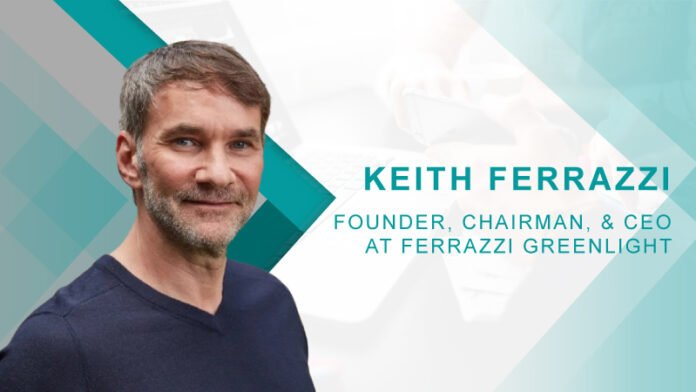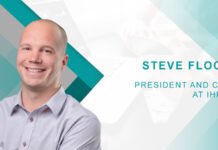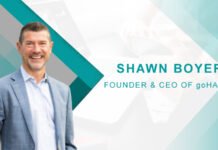Keith, it’s a pleasure to have you on HRTech Cube. Do share a bit about your professional journey and what led you to become the founder of Ferrazzi Greenlight and a best-selling author of four books.
My father was a forklift operator for a small steel company in the 1970s when I was growing up in Latrobe, Pennsylvania. He would come home and sit at the dinner table, telling us of his frustration with his union boss, who told him to slow down his pace of work. Dad was making everyone else look bad
With the crash of the steel industry, soon he became a mostly unemployed steelworker, and he would take any job he could find, digging ditches, sweeping up at construction sites at one point. My mom scrubbed the floors of the homes of our richer neighbors for $20 a day. I swore someday I would help fix American manufacturing if it could prevent similar suffering from other families.
I became fascinated with organizations and, specifically, marshaling the forces of employees and teams to turn around and disrupt old ways of working. I later went on to Yale, Harvard Business School and also served as the youngest Chief Marketing Officer of Deloitte. Eventually, I formed a coaching firm consultancy set forth on that vision of disrupting antiquated work processes.
In your latest book, Never Lead Alone: 10 Shifts from Leadership to Teamship, you emphasize the shift from leadership to teamship. What makes this shift so critical in today’s world?
Today, in what could have been a post pandemic reboot of ways of working, the global world of business is facing a lack of curiosity and focus on new ways of working. Fewer than 15% of companies have truly relooked at their ways of collaborating. We briefly changed where we worked but not how we worked. We have merely rubberbanded back into the same old ways. The volatility in the world has called for ways of working to change vastly, and with artificial intelligence the pressure to relook at entirely new ways is upon us, not just to apply AI incrementally but to existing ways of working. But we have failed to change the way we work, holding on to practices and tools created decades ago.
Teamship is engineered for today’s volatile world. The volatility and performance pressure in the world around us call for extreme and collective purposefulness of teammates. We should have no time for frozen routines and ossified protocols that pose obstacles to growth. In my last book, “Competing in the New World of Work,” I described a methodology called radical adaptability, based on interviews and observations with more than 2,000 leaders about accelerating change through uncertainty. Radical adaptability calls for a culture rooted in foresight, inclusion, agility, and resilience and the team behaviors and practices that will drive that. The aim is a working culture of agile and bold innovation and broader co-creation that happens in an accelerated way. This teamship practices outlined in “Never Lead Alone” can be adopted to any team imaginable.
With the rise of return-to-office mandates, what are the limitations of the traditional office model, and how can organizations improve collaboration?
Our research has uncovered that some of the greatest erosion of shareholder value comes from one single debilitating habit of most teammates: conflict avoidance. Whether in the office or operating remotely, teamship practices address this behavior. Asked to rate the level of courageous dialogue in meetings between 0 and 5, workers cite a mere 2.4. World-class teams embrace candor and do not tolerate backchannel conversations. They have shifted to an agreement to care enough about each other’s success that nothing will be withheld from the team that might stand in the way of finding the best solutions.
Re-engineering how we work will require a broad assault on many fronts, and we can start with a simple one: in-person meetings. This remains the primary way that companies get their staff to collaborate, but meetings are the bane of organizational existence. By collaborating online first and meeting later, teams can get done in only one meeting which previously required three gatherings to get decided. This cuts cycle time for innovation and increases the boldness factor.
What is the biggest barrier to achieving true cross-functional collaboration, and how can HR technology overcome this challenge?
We must lean in and relook at the ways we collaborate and not just pave over the cow paths as an old dear friend, Michael Hammer, once called for in his Harvard Business Review article “Regineering Work: Don’t Automate, Obliterate.” The silos of working again are actually holding us back. AI is being looked at by IT departments without the kind of cross functional curiosity and partnerships that are called upon for all new technologies in business. HR, IT and the business must be jointly focused on reinvention. The same missed opportunity seemed to be passed over and lost with collaborative software that offered new ways to span out and engage across silos faster and more inclusively, leading to bolder and more innovative solutions that allow for greater flexibility of where and how we work. But we still cling to meetings as the way in which we collaborate. Ultimately, world-class teams should think of collaboration not as a meeting but as a Collaboration Stack—a series of different modes of collaboration, from asynchronous to in-person, each of which must be purposefully engineered for.
What role does trust play in building effective teams, and how can HR tech enhance engagement, trust, and communication?
Only 41 percent of team members believe caring, trusting, and supportive relationships exist with their peers. Fifty-eight percent of employees say that they trust strangers more than they trust their own associates at work. Building relationships among team members on a foundation of commitment and empathy is critical to providing an environment of forgiveness and caring enough to challenge each other. Collaborative, HR technology can help teams transparently share and critique ideas and solicit bold thinking to further trust.
What are the best practices for organizations to maintain strong, collaborative teams in remote or hybrid work settings?
I’ve outlined three teamship practices that support the shift from serendipitous relationships to purposeful bond-building. One of the most powerful practices we have coached teams all over the world to is the Personal-Professional Check-In, which is part of the three practices we use regularly.
- Sweet and Sour: Is a five-minute check at the beginning of meetings to ask team members to share something that’s going well and something that’s more challenging in their life right now.
- Personal Professional Check-In: Is a deeper check-in that can forge instant bonds between strangers, but for teams it is often the tipping point of creating trust between peers.
- Intimacy Dinner: A once-a-quarter dinner that’s built around storytelling–the stories that made us who we are today.
As organizations shift toward teamship, what skills should HR focus on to evolve the leadership development programs?
Organizations should focus on creating an ever-present peer-to-peer coaching culture within and among their teams. It’s called co-elevation— the commitment to the mission and commitment to care about each other enough not to let each other fail— in practice.This new approach to feedback and its link to personal development and achievement and business outcomes is a fundamentally different social contract than most of us have experienced elsewhere. It all starts with a very aspirational set of promises for every associate that they all actively need to fulfill for each other.
What metrics should organizations track to evaluate team transformation success, and how can HR tech aid in measuring progress?
We’ve discovered that it will free up 30 percent of a leader’s time to have the team step up instead of putting all the responsibility on the leader. In addition, committing to a team of co-elevating peers will allow leaders to accelerate innovation, boldness, and extraordinary outcomes. The resulting outcomes almost always exceed what could have been accomplished through regular channels within the org chart. When we commit to teamship and the Co-elevation behaviors, we work with more positive energy, generate bolder innovative ideas, expand our abilities, and execute faster. Versus typical teams, our research shows Co-elevating teams gain a 79 percent increase in candor, a 46 percent increase in collaboration, and a 44 percent increase in accountability. Unfortunately, this is a standard of teamship that only 15 percent of the world’s teams attain today.
How do data and diagnostic assessments shape your coaching methodology and team development strategies?
We use a diagnostic tool with 20 questions and a 0–5 scoring system to begin what I call recontracting: This lets us open the discussion with teams about their purposefully engineered social contract and then, unlike detached conversations about culture and values, we can audit our progress every month through observing and discussing the adoption of simple high-return teamship practices. These diagnostic questions span the 10 shifts to teamship.
What advice would you give HR leaders to foster trust and collaboration in remote or hybrid teams?
Building relationships among team members on a foundation of commitment and empathy is critical to providing an environment of forgiveness and caring enough to challenge each other. Often teams have pockets of broken trust between peers, and, left unchecked, this can develop into deep resentments that erode shareholder value. Yet all too often, the team sits by seemingly helplessly enduring poor results, behavior, and performance. Traditionally, bond-building happened when someone walked down the hall and bumped into another person at the watercooler. It was organic. That’s why we hear leaders say they want to see people get back to the office; they want that kind of culture-building to happen. But the problem with this traditional form of relationship-building, which we might call serendipitous bond- building, is that it happens by chance. Teams that have shifted to purposeful bonding, especially those who are hybrid, have reaped high cultural rewards well above relying on the old walk down the hallway.
A quote or advice from the author
“You don’t think your way to a new way of acting; You act your way to a new way of thinking.”

Keith Ferrazzi ,Founder, Chairman, & CEO at Ferrazzi Greenlight
Keith Ferrazzi is a renowned executive team coach, keynote speaker, influential thought leader and founder of Ferrazzi Greenlight, where he has spent more than 20 years coaching Fortune 500 companies, unicorn startups, and even governments. Keith leads the Greenlight Research Institute, which is focused on team transformation. He is a business coach who challenges the way teams work to achieve breakthrough results through more connection and collaboration across silos, with a revolutionary shift from leadership to teamship. His Radical Innovators Collaborative brings together disruptive thinkers for peer-to-peer interaction and ongoing best practice sharing. Keith’s columns are regularly published in Harvard Business Review, Forbes, The Wall Street Journal, Fortune, Fast Company, and Inc. Magazine. Ferrazzi is also a #1 New York Times Bestselling author with familiar titles like Never Eat Alone, Leading Without Authority, and Competing in the New World of Work. His latest book, Never Lead Alone: 10 Shifts from Leadership to Teamship, draws on two decades of team coaching experience and research insights from 3,000+ diagnostic assessments with leading organizations. He is a 2024 recipient of the Coaches 50 Award, which recognizes the world’s most influential executive coaches. Ferrazzi is also a philanthropist and strategic investor, where he is committed to making a positive impact on society.












